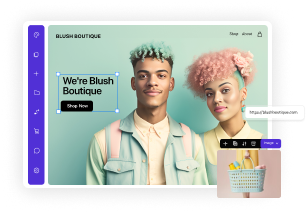How To Get Sponsored By Brands In 2025: Step-By-Step
Updated Mar 21, 2025 | Published Mar 19, 2025 | 11 min read

If getting paid to promote products that you already know and love seems like your dream job, you’ll be delighted to know that it actually exists. If you are a content creator, pairing with your favorite brands to promote their products in your content is an excellent way to create a new revenue stream.
To secure a lucrative sponsorship deal with a brand, you need to consider what the brand will gain from the arrangement. If you are looking for corporate sponsors, you must have a clear strategy for targeting the right people and showing them how much value you can provide.
Let’s examine how to get sponsored by brands in 2025 and the steps required to turn it into a long-term deal.
Brand sponsorship occurs when a brand partners with a content creator—a blogger, YouTuber, or social influencer—to promote its brand naturally in their content. A large following is often associated with brand sponsorship, though that is not the only factor.
Brand sponsorship benefits both parties; the content creator increases their revenue and builds trust with their audience, while the brand gets exposure to a new audience. From nano-influencers to established TikTokers, brands are always looking for a variety of people to partner with.
If you think a brand sponsorship involves money pouring into your bank account, you must understand that this is not always the case. There are many types of brand sponsorship, and not all involve wads of cash changing hands.
You may be aiming for one particular type of sponsorship, or you could be happy to take anything a brand can offer. Either way, you need to find brand deals first. If you know where to look, there are many ways to connect with brands.
If brands are going to part with their cash or products, they need to know they will get a good return on their investment. They will be looking for:
Ready to build your website? Get started with Friday today.
If the thought of finding brand sponsorship is overwhelming, it helps to break it down into smaller, more achievable steps. Here is a step-by-step guide to securing that brand deal.
The first step to getting other brands interested is to know your brand. Sponsoring brands will be interested in your audience insights, so ensure you are familiar with them first.
Take time to analyze your target audience so you can choose brands that perfectly align with their needs.
Create social media accounts on as many platforms as possible if you want brand sponsorship. Don’t play it safe with just one or two; brands need to know that your message will reach their audience across multiple platforms.
If you don’t have a YouTube channel yet, consider starting one as part of your efforts to get sponsored. Video content can create a more emotional connection with your audience, allowing you to review any complimentary products you receive. Check out our suggestions for YouTube channel names to give you some inspiration.
Having your own website is also essential. It will make you look more professional to brands and give you another outlet to promote them.
Once you have set up your digital platforms, it is time to grow your following. Although it is not the only factor in securing brand sponsorship, the more people you engage with regularly, the higher the chance brands will consider you a valuable asset.
You don’t need millions of followers to be successful; micro-influencers with high quality and engagement can be just as appealing to brands.
The key to increasing your customer base is consistency. Post regularly across your social media accounts. You can often repurpose content to make it suitable for other platforms, which saves you time.
Engage with your followers regularly, whether commenting on your YouTube channel or website or creating interactive content on social media.
You can also create a blog for your own site, write guest posts on other websites with authority in your niche, or partner with other influencers promoting similar digital products to reach a wider audience.
To appear more professional and save time, create a media kit before you contact brands. A media kit will tell potential sponsors everything they need to know about working with you and prevent you from repeating the same information to every brand.
Treat your media kit as a resume for sponsorship. Keep it brief but informative, and make it visually appealing and uncluttered.
Include a section about yourself and your brand. Inject some personality to help you stand out from the crowd. Provide detailed information about your audience demographics, and be honest. You don’t want to waste time in conversation with someone who is ultimately not a good fit.
Display your best social metrics to show your value so brands know how many people the campaign could reach. Also, make it clear here if you are focused on one particular type of sponsorship.
Be sure to include your contact information so the brand can reach out after reviewing your kit.
You may think you would be happy to work with any brand, but for a successful campaign, you must choose brands that are a good match. This approach will benefit you and the brand and reduce the chance of disappointment later.
Look for brands in your niche or sub-niche that align with your values. They will likely be a good fit if their target market matches yours. Knowing who they have partnered with before will also give you an idea of how likely the partnership will be.
Though you may be dreaming of pairing with established companies, you will find more success targeting and supporting small businesses that need exposure and social engagement. You can also search on influencer platforms and reach out directly to brands that you know in your niche.
Once you have chosen brands you would like to work with, it is time to reach out. If your sponsorship proposal is strong, you have a better chance of them agreeing to a deal.
Sending out an email request you wrote during your lunch hour is not going to cut it. Your sponsorship proposal should be a professional pitch that shows the brand that you are an attractive prospect.
It should contain similar information to your media kit but be tailored to your target brand. Include the most impressive information regarding your metrics to demonstrate your reach.
Outline what you will offer, and include various packages at different prices. Be as clear as possible to avoid both of you wasting your time on a deal that isn’t a good fit.
Finish your sponsorship pitch with a compelling call to action. If you don’t ask the brands to respond or set up a call, you can’t complain when they don’t.
Start creating your website today with Friday’s free trial.
Unfortunately, no matter how long you spend making it perfect, not every potential sponsor will reply to your proposal. A lock of response doesn’t mean they are not interested—brand managers are incredibly busy people, and they may need a nudge to remind them about you.
Wait a couple of weeks, and if you haven’t heard back, reach out again. Please don’t be pushy, as that can put them off. Keep the tone light and remind them that you are keen to collaborate. If you think it may nudge them in the right direction, offer sponsor incentives, such as discounted rates or bonus promotions.
Try an alternative method of communication each time, in case one is more closely monitored than others. If you have sent two follow-up emails without a response, take the hint and move on to another brand.
Once you have the attention of your chosen brand, it is time to start negotiating. This step is a delicate balance between knowing your worth and not underselling yourself, and understanding their budget. You don’t want to put them off by making an outlandish suggestion.
If their budget doesn’t stretch to your minimum fee, consider reducing the sponsorship package offered so that you can get the deal without undercutting yourself. For smaller businesses, consider in-kind sponsorships instead.
Be very clear on what you are delivering and how it will be measured. If the company expects their traffic to increase, ensure this is agreed upon in writing to avoid misunderstandings.
If you hope to secure a long-term deal with this brand, you need to impress the key decision makers. Instead of aiming to fulfill their expectations, plan to exceed them.
Throw everything into this campaign, engaging with your audience more than ever. Keep a note of the analytics throughout to show the brand what you have achieved. Keep in touch with them during the sponsorship campaign, too–if they have to chase you, they may feel you are not as committed.
Your ultimate goal should not be to engage in a single sponsorship opportunity but to partner with this business long-term in a mutually beneficial collaboration. Treat the company as though they were a long-term client, providing them with feedback and the results of your hard work as you progress.
Suggest how you could provide future value and ask for a review of the campaign once it is completed. Even if the brand doesn’t want to prolong the relationship, stay in touch in the hope that the value you provided them will lead to a future collaboration.
If you are a content creator, securing a brand sponsorship can make a big difference to your business. No matter how big your following, brands could be looking to collaborate with a creator like you.
Following these steps in our guide should give you the confidence to contact brands and close a deal that will move you both forward.
